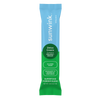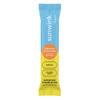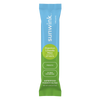Soluble vs. Insoluble Fiber - Key Differences

If you’re into nutrition, you know fiber is super important for a healthy diet. Because fiber doesn’t digest, it passes through your digestive system intact, doing all kinds of awesome things along the way.
While all types of fiber are necessary, it’s important to understand the difference between the two main types found in high-fiber foods: soluble and insoluble. Knowing when and where to get each type of fiber can make your diet well-rounded, which can support optimal gut health.
Ready to learn more? Keep reading this guide from Sunwink on the difference between soluble and insoluble fiber, in addition to where to find each type.
Soluble vs. Insoluble Fiber: What’s the Difference?
The main difference between soluble and insoluble fibers is how they interact with your digestive tract.
Soluble fiber dissolves in the gut. As it dissolves, it can create a gel-like substance that may improve digestion in many ways. Soluble fiber is also linked to various benefits, such as supporting healthy blood sugar levels and cholesterol levels.
Insoluble fiber, on the other hand, does not dissolve in water. It attracts water into your stool, which makes it easier to pass without straining the digestive tract. Insoluble fiber is linked to improved bowel movements, which is another way to support a healthy gut.
What Are the Benefits of Fiber?
The most well-known benefit of fiber is its ability to support thriving gut bacteria. By improving bowel movements, fiber can reduce constipation, bloating, and gas. But that’s not all fiber is good for. There are plenty of benefits to eating fiber, including some of the following:
- Weightmanagement: Fiber takes a while to pass through your digestive tract, which means you stay full for longer. It can also fill up your belly, making you less likely to overeat, which can help with weight loss. Combined, these factors can help to reduce your caloric intake, making it easier to stay at a healthy weight.
- Balancedcholesterollevels: Fiber helps to support proper levels of cholesterol in your blood. It may take as little as an extra five grams of fiber to see the benefits for your cholesterol levels.
- Stable blood sugar levels: By supporting healthy nutrient absorption, fiber may work to prevent sugar spikes following meals. This can help keep you from crashing shortly after eating and keep your appetite steady.
- Hormonalbalance: A sluggish digestive system can store excess hormones and lead to a hormonal imbalance. Fiber is crucial for supporting your hormone levels and overall wellness.
How Much Fiber Do I Need?
Dietary fiber is an important part of a balanced diet. Unfortunately, less than half of American adults get their recommended daily fiber intake (despite eating lots of carbohydrates).
So, how much fiber should you eat in total? Well, that mainly depends on your age and gender. In general, it’s recommended that men get 38 grams per day if they’re under 50. If they’re over 50, they should get 30 grams per day.
For women under the age of 50, the recommended daily amount (RDA) is 30 grams. For women over 50, it’s 21 grams. It may seem like a lot, but there are so many sources of fiber that it would be impossible to get bored.
If getting enough fiber is a problem for you, you may consider taking fiber supplements — especially if you’re seriously deficient in fiber as per your doctor. But whole food sources are always preferred because they also come with vitamins, minerals, and antioxidants that can promote whole-body wellness.
For the best of both worlds, try our Digestion Lemon Sparkling Superfood Tonic. It’s made with potent sources of fiber, like Chicory Root. Because it includes whole Superfoods, It’s not exactly a supplement — but, unlike whole foods, it comes with zero cooking requirement!
What Are Some Sources of Fiber?
Remember that both soluble and insoluble fiber make up a well-rounded diet. That’s why you should try to incorporate an equal mix of both into your meals.
Some good sources of soluble fiber include plant-based foods like:
- Oatmeal
- Beans
- Legumes (lentils, green beans)
- Peas
- Apples
- Carrots
- Citrus fruits
- Psyllium husks
To add more soluble fiber to your diet, you can sprinkle psyllium on top of your food, make a hearty soup with various types of legumes, and snack on fresh fruit, like apples, throughout the day.
Of course, don’t forget the sources of insoluble fiber.
Some sources of this nutrient include:
- Whole grains (brown rice, oat bran, certain cereals)
- Cruciferous veggies (broccoli, cauliflower, Brussels sprouts)
- Potatoes
- Nuts (cashews, almonds, peanuts)
- Wheat bran
To add more insoluble fiber to your diet, you can eat healthy whole grains at every meal, use whole-wheat flour in your baking recipes, incorporate cruciferous veggies at every meal, and snack on nuts throughout the day.
Can You Take Too Much Fiber?
Of course, it is possible to have too much of a good thing. If you eat too much fiber, which will typically hover above 70 grams per day, then you can experience gas, constipation, and bloating.
If you experience these side effects, then try to cut down to the recommended daily amount. Sometimes, increasing fiber too quickly can cause unpleasant symptoms. But this should go away once your body gets used to fiber.
If you continue to experience digestive issues, talk to your doctor about the possible causes. It may be that it isn’t fiber that’s the problem but something else, like irritable bowel syndrome (IBS).
Also, remember to increase your water consumption along with fiber. All forms of dietary fiber need ample fluids in order to pass through the digestive tract. Being dehydrated can make excess fiber sit in your GI tract, which can give you an unpleasantly full feeling that’s accompanied by bloating and constipation.
Superfoods for Digestion
For digestion that works as well as it should, fiber can be your best friend.
While there are some key differences between soluble and insoluble fiber, both forms are needed for a healthy and happy gut. Try sticking to whole food sources of fiber, like fruits, veggies, and whole grains.
And if you want some extra help, look no further than fiber-rich Superfoods. Sunwink’s Sparkling Superfood Tonics and Superfood Powders are made with superstar ingredients like Chicory Root, Adaptogenic Mushrooms, and Dandelion Root.
You can find them in our Superfood Powder Variety Pack — for a convenient (and delicious) way to support your digestive health.
Sources:
Fat/Fiber intakes and sex hormones in healthy premenopausal women in USA | PMC






